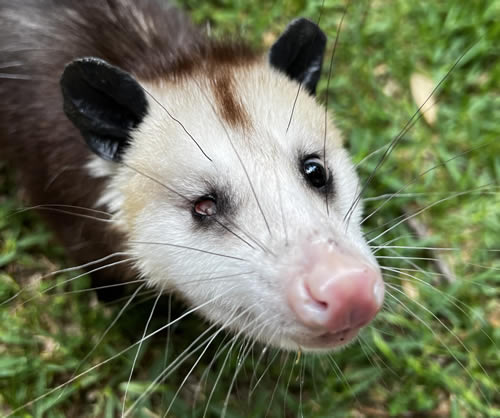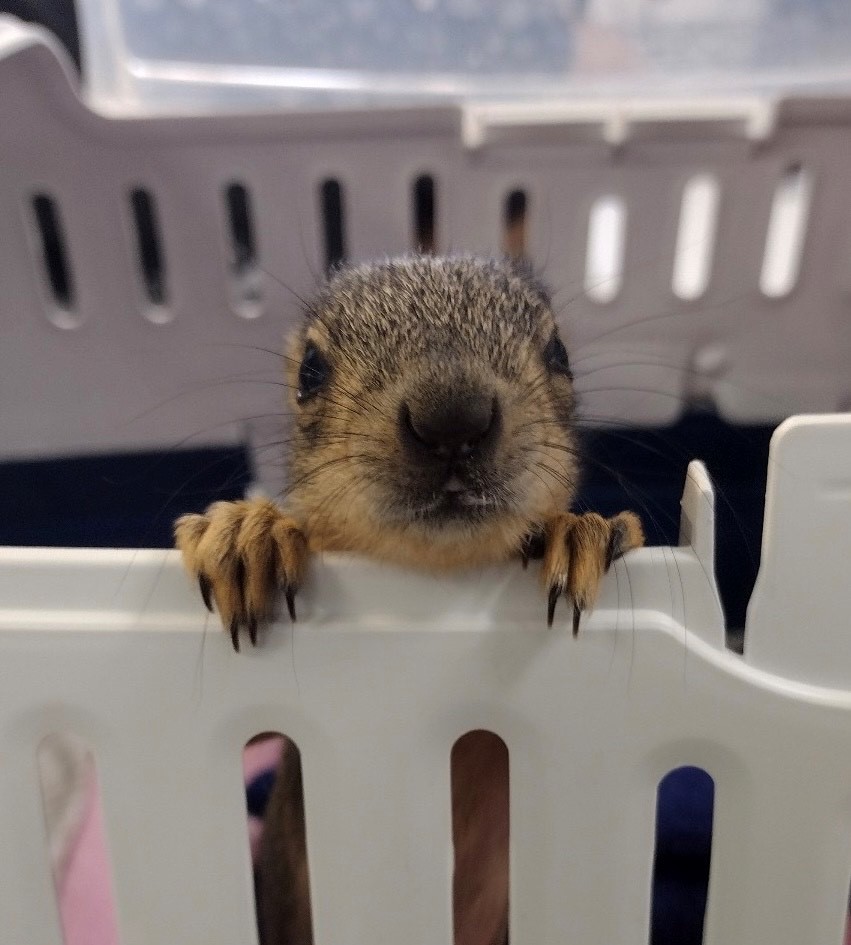By Deb Near, Animal Care Program Supervisor
Squirrels, squirrels everywhere! We are in the thick of baby squirrel season right now here at TWRC Wildlife Center, and it sure is busy! From tiny, orphaned squirrels, to juveniles that require medical treatment, we are up to our eyeballs in these adorable, furry rodents.

There are three squirrel species native to Texas, and we regularly admit all three species here at TWRC Wildlife Center. The two main species that we receive are the Eastern Gray Squirrel (Sciurus carolinensis) and the Eastern Fox Squirrel (Sciurus niger). Both species are diurnal tree squirrels, meaning that they are most active during daylight hours. Occasionally, we receive the Southern Flying Squirrel (Glaucomys volans). Unlike the gray and fox squirrels, flying squirrels are nocturnal. Being that they are both nocturnal and a more aggressive species, it is a challenge to care for them during rehabilitation. Currently, all admitted flying squirrels are redirected to home-rehabbers who are trained to handle such a unique critter.

Squirrels (family Sciuridae) belong to the order Rodentia, which is the largest order within the mammal classification. Rodents are a widely diverse group, containing animals such as rats, mice, porcupines, chinchillas, prairie dogs, groundhogs….and, of course, squirrels.
Fun Fact: One of the defining characteristics for rodents, and therefore squirrels, is their two pairs of continuously growing incisors. The growth of these upper and lower incisor pairs is kept in check when rodents grind their teeth together as they gnaw and chew on whatever is handy.
When baby squirrels are very small, it can be difficult to differentiate between the gray and the fox species. Over time, their differences become increasingly apparent. Gray squirrels will develop a white or cream-colored belly and a white tail tip, whereas a fox squirrel will have an orange-ish-colored belly and a black tail tip. Head and ear shapes are also different for each species. Gray squirrels have a narrower head and snout, with triangular-shaped ears. Fox squirrels have a wider snout and rounded ears. Also, fox squirrels are larger and tend to mature at a slower rate; typically, a 90-gram fox squirrel will be the same age as an 80-gram gray squirrel - that is, around four weeks old. Because of this trend, we sometimes like to refer to them as “big babies”!
A common question we receive on our wildlife hotline is whether the baby animal that has been found is actually a squirrel or some other baby mammal. At a very small size, sometimes it’s difficult to tell what kind of animal has been found. A good rule of thumb is to look at the toenails. If the nails are black rather than clear, then you have a baby squirrel! Opossums, rats, and mice will have clear nails.

Gray and fox squirrels have two breeding seasons per year. The first generally runs from December to January, meaning we begin to admit babies from March through mid-May. They also breed again between June and July, meaning we get more babies from August - October. Babies are raised exclusively by their mothers. Nests are located either in the upper branches of trees or in a hollow in the trunk. A typical litter consists of between two and four babies - occasionally just one, and sometimes up to six.

Every so often, we receive a squirrel with unique colorations caused by a genetic mutation. These mutations typically result in darker (black) fur or even lighter (white) fur! This doesn't mean they are a different species, just variations of either the gray or fox squirrel. Black fur has been found in both species and is due to a mutation on a gene that produces excess pigmentation. Most black squirrels found in the eastern and northern US are gray squirrels, whereas the ones found more westward, including in Texas, tend to be fox squirrels. Black squirrels are quite rare. White squirrels, however, are even more so.
There are two types of white squirrels found in the wild: albino, and leucistic (white morph). Both are the result of reduced pigmentation, although the mutations are found on different genes. Both are almost always gray squirrels, and sightings of them are very, very rare. The easiest way to tell the difference between the two variations is to look at the eyes: albino squirrels will have red or blue eyes, whereas the white morph squirrels will have the dark eyes typical of normal squirrels.
Just like all wild animals, squirrels play an important role in their native ecosystem as a key prey species, meaning that they are a major source of food for native predators such as hawks, eagles, snakes, coyotes, and more. They also play an important role in seed dispersal for forest regeneration, either by spreading seeds through their feces or by the caches that they hoard for future meals. Also, they aren't the first critter that comes to mind when one thinks of pollinators, but they do a great job at spreading pollen from plant to plant, ensuring that future generations of that food source continue to thrive!
There's no question that baby squirrels are cute and adorable. If you find one that may need assistance, it might be tempting to take it home and try to care for it yourself. You might even be tempted to raise it as a pet! This is a very bad idea! Aside from the fact that squirrels are a protected species and therefore illegal to keep in your home without a permit, any wild animal is much better off living its life in the wild. Also, if not properly trained, one can do more harm than good trying to help a compromised animal. It is for these reasons that TWRC Wildlife Center exists. If you do happen to run across a baby squirrel that you suspect needs help, click on our link here: https://twrcwildlife.tempurl.host/found-an-animal/squirrels/.



